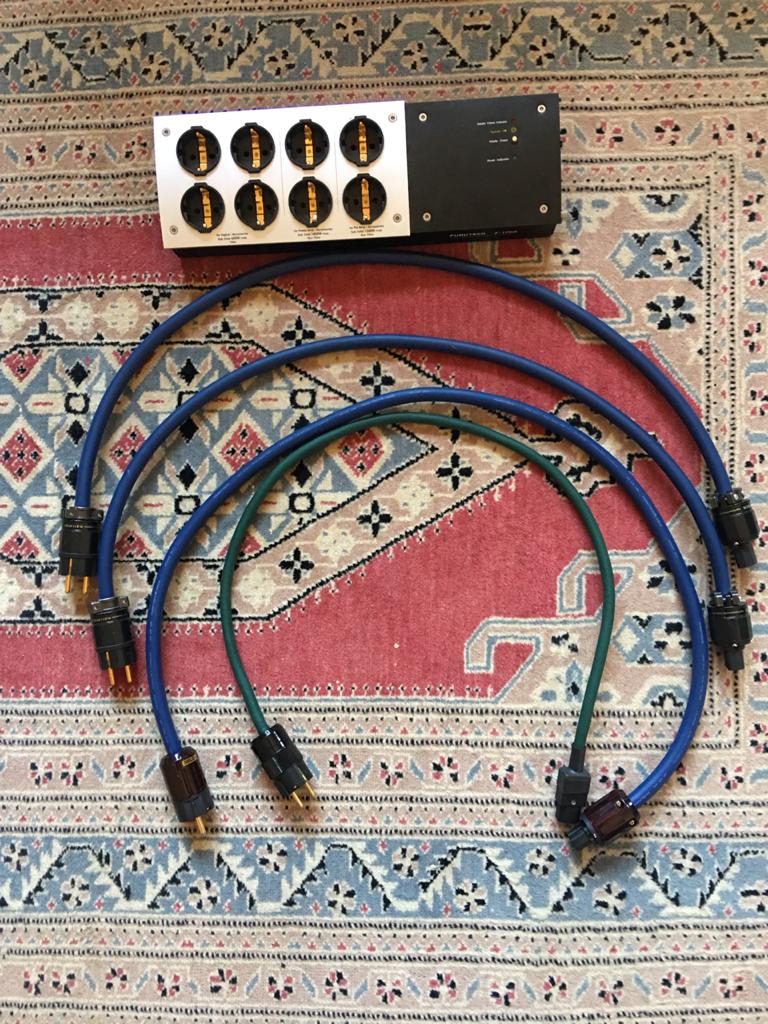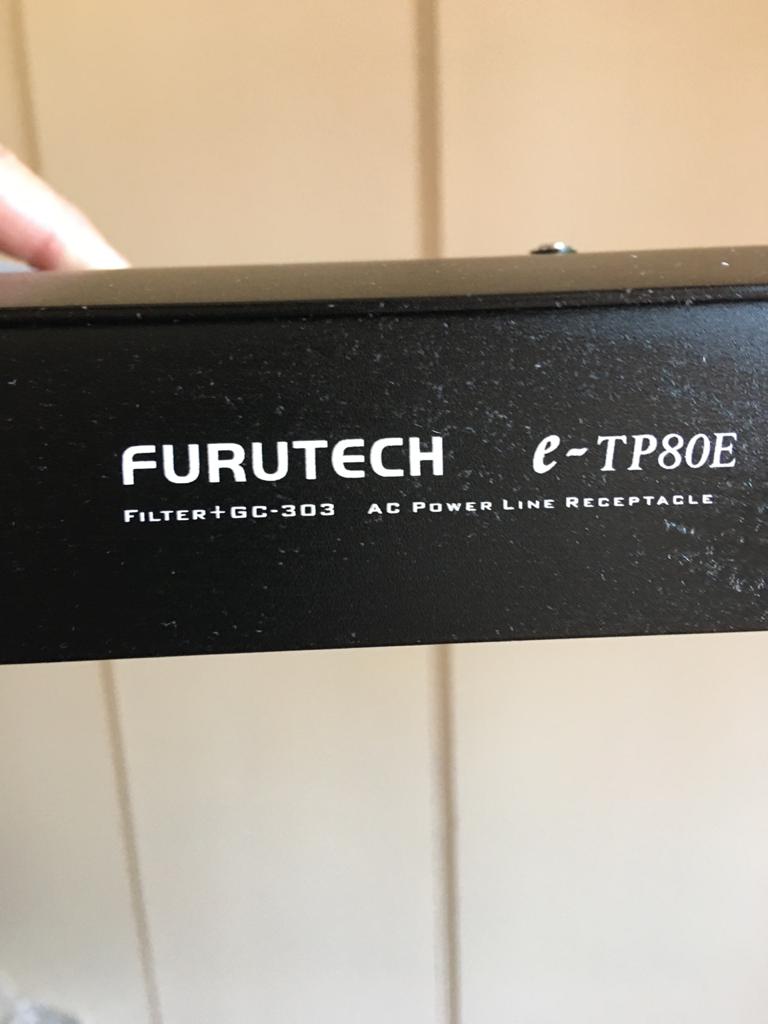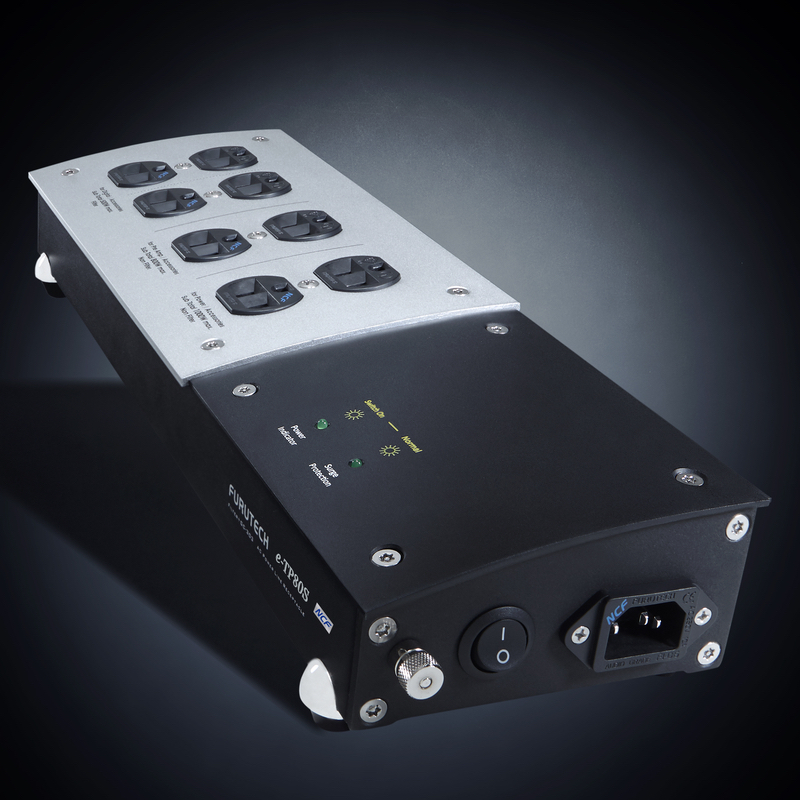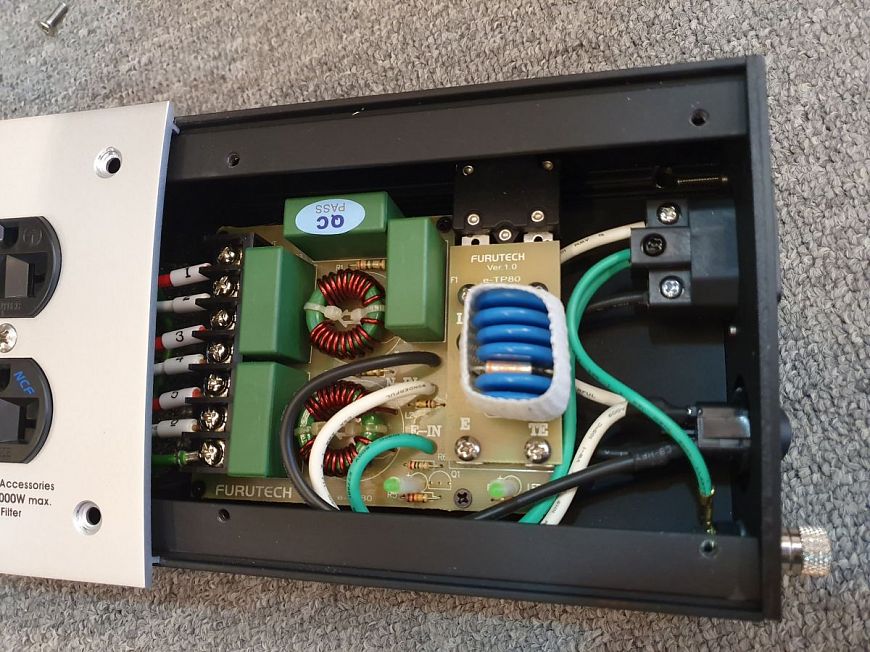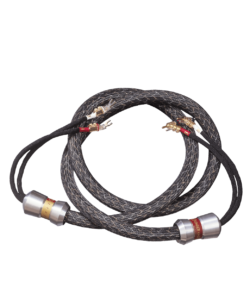Furutech e-TP80 AC Power Filter Distributor
Original price was: R35,000.00.R9,000.00Current price is: R9,000.00.
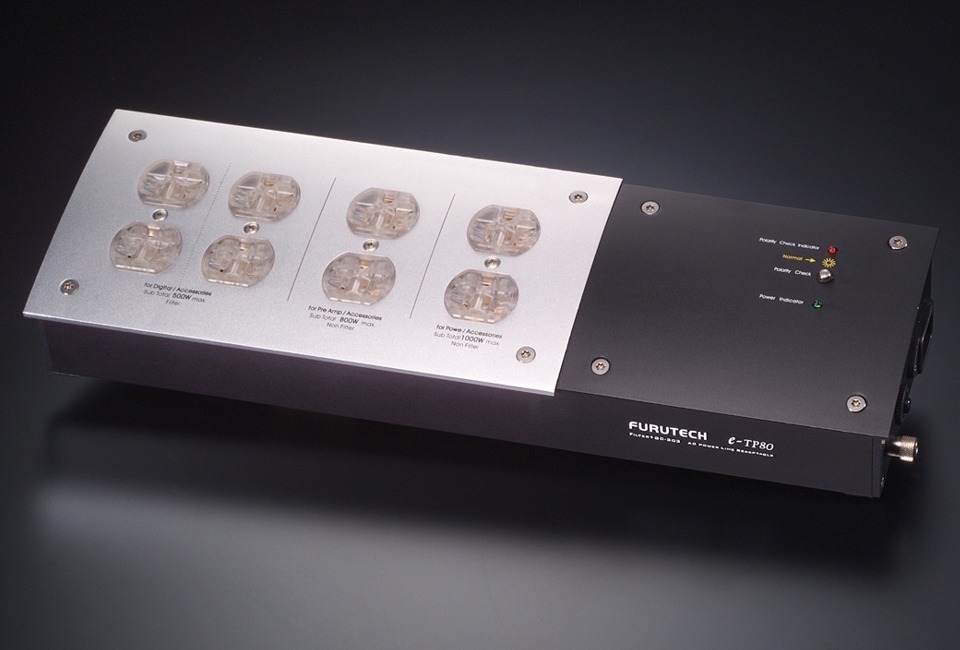
PROS: Top-to-bottom purity, detail and dynamics; no discernible sins of omission or commission; superb build quality.
CONS: Won’t help a mediocre system or transform bad power; look elsewhere if you want fancy features like switching or power factor correction.
It started back in the middle 80s, or so. That’s when I remember the initial stirrings about how changes to AC related components could improve the sound of a stereo system. I recall reading about power cords in Stereophile magazine for the first time. How odd that something, a mere conductor of electricity, could impact the music coming out of speakers. After all, the tiny voltages carrying the musical signal are greatly isolated from the raw energy coming out of a wall. Large transformers, and filter caps measuring many thousands of µF were there for a reason. Their job, or so I thought, was to take power generated many miles away in a plant burning coal, or plutonium or something, and turn it into my music. And between my house and the power plant there were, and still are, literally, tons of cable suspended from towering utility poles traversing pastures, forests and interstate highways. Next to the street I’m on, there is a wooden pole with a rather large transformer affixed to its top. Wires go in and wires come out; several of those wires go to my house – they power my stereo.
The trek of electrons starting so many miles away ends at my wall. Of course, those electrons also power the microwave, refrigerator, clocks, lightbulbs and any number of things populating a modern home. It’s something I take for granted until for some reason the power goes out. It’s only then that I think of ways to punish the power company for my inconvenience. Otherwise, one electron is as good as another for making sure my clock radio comes on as directed every morning. It’s a 60 Hz sine wave after all, what’s the big deal. Where I live, the voltage hovers around 122 volts with amperage sufficient to fry your eyeballs if you touch it with impunity. And while the voltage is a little high, it’s not enough to cause reliability problems or overcooked appliances. How then, could my stereo be materially and substantially changed sonically by 6 feet of cable and what amounts to a power strip? I don’t really know the answer to my self-imposed question. But I do know, and I don’t care what the uninformed, and delusional naysayers say, I can make a sound system suck or sing with the right combination of power cords and AC line conditioning. Yes, the last six feet does make a difference.
Ironically, the first power cord review I recall reading in Stereophile was negative. The writer heard a difference with the insertion of the cord, but he didn’t like it. I remember, when reading his many complaints, that the entire concept of an aftermarket power cord perplexed him. How could a cord plugged into a preamplifier make any difference good or bad? In retrospect, I’ll bet that the reviewer got a cord wired with the polarity reversed. Otherwise, it should have sounded better with something. During the over twenty years that I spent listening to power cords for Bound for Sound, only once did I come across a cord that sounded bad at everything and with every component I tried it with. I won’t name the manufacturer, he’s gone, the market took care of him, but over the years I’ve auditioned over 200 different cords, and reviewed a goodly number of those, and if I’ve learned anything it’s – never think you’ve got it all figured out… because, you don’t.
THE HARDWARE
I could cover these components together, but I choose not to. Elite Audio/Video sent me two power cords and an e-TP80 Power Distributor ($1,995), all from Furutech – I like them a lot. For some, the e-TP80 is nothing more than a glorified, and expensive, power strip. Thinking that would be a mistake. The version sent to me is filled with some nice distributor-added options such as the special production AC outlets, all eight of them. These AC outlets (GTX-NCF) are anything but ordinary. The inner workings are Rhodium over pure copper. The Rhodium is super polished for an ultra-smooth contact area for hooking up with high-end AC plugs. Stainless steel springs are used to maintain pressure at the contact points. The iec connector has pure copper tongs. The Furutech even has negative ions inside! It’s a granular material called 3M CG303. I looked up what an ion is and discovered that it’s an atom that has either gained or lost an electron. If it has lost an electron, it’s a positive ion. If the atom has gained an electron, it is a negative ion. The Director has a bunch of negative ions inside it, or so Furutech says. I don’t know where they came up with the extra electrons, and I don’t know how negative ions are good for a sound system. All I know, is that from the overall performance of this device, negative ions are a good thing. The chassis is extremely well made, and to the hand, it feels like it weighs more than it should. It has the feel of something intended to be elite.
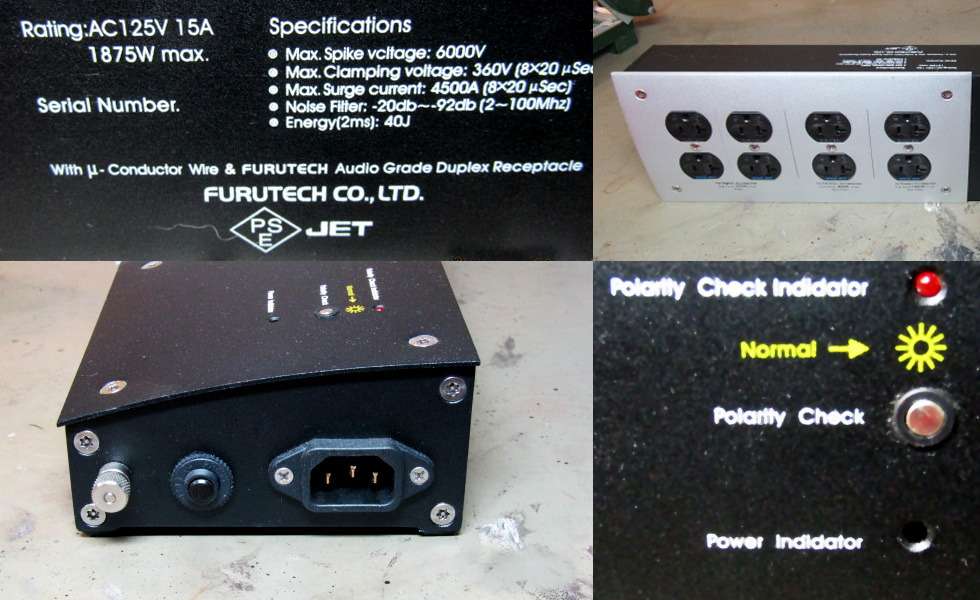
Wiring inside of the e-TP80 is solid core Furutech. What I’ve described for you are the extras added goodies which set this Elite (Scot) modified e-TP80 above the standard Furutech Power Distributor which runs a sweet $799.00. I trust that the standard Furutech Distributor is a great product and excellent value. In my opinion, however, the Elite modified unit is in a class all of its own.
When compared to the price fetched by some things audiophile, the price of the Director at $1,995.00 isn’t that bad. More than mad money, it’s still within range for the serious music lover, plus the eight additional outlets where you need them is priceless. Nothing worse than having a single outlet with two plugs out of reach of even your longest power cords. There are power strip options, everything from cheap plastic strips for sale at Walmart to slightly upscale versions of the same sold at Menards and Lowe’s. EBay has lots of nice looking strips one can basically order direct from China… nice looking pieces that hide their internal workings and offer no domestic support in case of problems. I can assure you that everything coming from Furutech is quality made and that Elite backs it up 100%.
[Editor note: Also beware counterfeits! Apparently there are fake Furutech (and Cardas, and Nordost, etc. etc.) parts being peddled that look all but identical to the real thing. Always buy from a trusted authorized source – if it seems too good to be true, it is. -MIY]
The Power Director has an IEC connector for use with a quality power cord. On top of the Distributor are four duplex electrical outlets. To the left are the outlets for low draw items such as preamps, DACs and the like. The DAC outlets have a simple, but effective, RFI/EMI circuit. To the right are outlets for heavier draw components such as televisions, power amps and subwoofers. Eight outlets in all. It’s not terribly important regarding what outlets you plug things into, but, I wouldn’t plug a large power amp into the DAC outlet, but that’s about it. The finishing touch is unit demagnetization and deep cryo freezing.
A POWER CORD

As I indicated earlier, I’m not going to cover the power cord section of this evaluation in the here and now. There are good reasons for that. What I can say is that the Furutech power cords sent to me are superb – perfect complements to the Power Distributor. The dynamic range they impart to a system is outstanding – NO compression whatsoever (they will pin your ears back). Persons with knowledge of various AC power conditioning and filtering techniques know that the price to be paid for a sense of tonal purity and imaging is oftentimes dynamic compression or a “softening” of edges. The natural expansion of dynamics with the Distributor and the Furutech power cords is as good as I’ve heard. I can discern no lessening, softening or compression of dynamics, contours or edges. And so as not to give the readers of TAWW the old soft shoe shuffle, I’ll be specific: I am very familiar with the LessLoss Firewall, PS Audio AC regenerators, various isolation transformers, battery powered AC such as the old Mark Brassfield, Tripplite, Audience (early model) and a friend’s Furman – and I like the Furutech the best. The Furutech Power Distributor is my “go to” device when determining what clean AC should sound like. But this is not a review of the Furutech power cords, as I have a conflict of interest regarding power cords: I make my own. It would not be fair to Furutech or myself (especially myself) to evaluate the Furutech power cords when I most certainly am biased in my assessment of power cords. For that reason, as much as I really like the Furutech power cords (and am not ashamed to say so), MIY will be reviewing them. He can say whatever he wants.
BACK TO THE POWER DIRECTOR
Now, that the cat is out of the bag, allow me to tell you what the Furutech AC Distributor does, and doesn’t do, so that you can make a determination if an audition is in order. The finest AC treatment architectures do some things very well. Almost all of the finer units have some very positive strengths. And in almost all AC units, the strengths outweigh the weaknesses. Otherwise there would be no reason to purchase any of them. However, I have yet to hear a single conventional AC treatment unit that didn’t have some form of negative associated with its performance. I hear no negatives with use of the Furutech Power Distributor. Among all of the positives heard with the PS Audio AC regenerators, after a while a heaviness, some call it a darkness, sets in that I wasn’t crazy about. Upon extended use I observed the Firewall to be softening transient information ever so much. In other ways it is exemplary. The Monarchy isolation transformer is a superb device, and I still use one. But use it long enough and one notices a subtle compression of extreme dynamics and a small curtailment of the extreme bass. All livable things made obvious after using the Furutech Power Distributor.
I am hesitant to say, but will anyway, that the greatest strength of the Director is that it does nothing negative to the sound, the absolute glory of the music shines forth. Listening notes confirm it, the Director strips away electronic artifacts by the boatload. The music is laid bare to observation, negative artifacts which ordinarily adorn the music in sometimes subtle ways are eliminated. Bass previously scrubbed away is realistically restored to a clean replica of that recorded. Dynamic contrasts, along with ambient details are again, laid bare. The “air” and natural space around performers is not exaggerated, still, if anything, it’s more recognizable than ever. This is the kind of product that refuses to impart enormous changes upon a sound system that is otherwise in need of a major overhaul, it doesn’t do huge things. Instead it does those small things that are not available elsewhere. Instead, it acts as a finisher. It’s where you go when you think your system is finished and its performance is already the envy of your friends, audiophile and non-audiophile, alike. It will not transform something mediocre into something wonderful. If it’s a miracle you need, then I’d go PS Audio or LessLoss. The Furutech is more of a “closer” than it is a middle relief man.
CONCLUSION
The basic Power Distributor can be purchased for less than $1,995.00. But the lower priced Distributors do not have the Rhodium over copper duplex outlets (all highly polished and so perfectly fitted for your AC plugs), along with a few other refinements that seem to further heighten performance. The top-of-the-line Furutech is a high-end performer that makes no compromises in terms of parts quality and construction. It’s what you give to the audiophile that has everything.

For obvious reasons, mainly coming from the profile of our portal, we will take on something readily available from dealers of the Japanese company Furutech. Ladies and Gentlemen, enter Furutech FP-3TS20 and FP-ALPHA 3 equipped with beautiful plugs FI-48R (IEC) and FI-E 48R.
Description
FEATURES
The AC waveform becomes severely distorted by ground noise, voltage spikes and sags, high frequency power supply noise from other components in your own system,plus radiated high frequency digital noise from processors and digital interconnects.
There are also distortion products at the top and bottom of the AC waveform created by switch-mode power supplies in electronic devices on the same circuit. Additionally, you’re never alone; your residential AC mains supply is shared with other apartments,
homes, and businesses on the same utility transformer. That’s why many audio and video enthusiasts notice their systems are more enjoyable late at night or on weekends!
The beautifully crafted special grade aluminum chassis effectively shields against another common problem, RFI (Radio Frequency Interference), and a layer of Formula GC-303 blocks EMI (Electro Magnetic Interference).
Internal wiring is FURUTECH μ-14 wire(14 AWG) that guarantees low resistance. Furutech Hyper Quality Audio Grade Receptacles are wired to the IEC AC input of the e-TP80. Receptacles feature 24K gold-plated phosphor bronze, non-magnetic conductors for stable, long lasting, optimized power transfer.Formula GC-303
GC-303 is a special material Furutech bonds to the interior bottom-plate of the chassis that absorbs EMI
(Electromagnetic Interference) generated by the internal fittings of the unit.Furutech’s Two-Stage Cryogenic and Demagnetizing Alpha Process
Using cutting-edge technology and materials, Furutech developed a low-temperature two-stage process that significantly improves every facet of audio and video performance. The treatment begins during the manufacturing process with a deep, conditioning cryogenic freeze of all metal parts. Using high-end refrigerants — liquid N2 or He — Furutech achieves temperatures of between -196 to -250°C. The treated parts actually change their molecular structure at these extremes of temperature relieving internal stress. The molecules bond together more tightly and the overall structure becomes more stable. This improves electrical conductivity and so power and signal transfer.Step two in the Alpha Process exposes these same parts to the patented Ring Demagnetization treatment. Ordinary high power magnets used for this purpose often increase magnetic effects; they leave some areas more magnetized than others. This patented process uses controlled attenuation to completely eliminate magnetization for immediately more vivid and colorful improvements. Ring Demagnetization further enhances conductivity of all treated materials.ALL metallic parts used in Furutech products go through the Alpha Process treatment to keep all connectors, conductors, and metal parts in a perfect stress-free, stable and highly conductive state.
The Final ResultThe 2-Step Alpha Cryogenic and Demagnetizing Process works in tandem with other designed-in features to create the most optimized AC power transfer possible. Furutech’s scientific outlook, total awareness and devotion to detail results in a greater sense of power, dynamics, and resolution, with cleaner, blacker backgrounds and a larger, more stable soundstage, vivid tonal colors and deeper extension at both ends of the frequency range. The e-TP80 will allow the delicacy, refinement and nuance of a performance through, along with micro- and macro-dynamics that will leave you breathlessly engaged. Displays of all types will exhibit greater, sharper resolution with less ghosting, color shift, “snow”, or vertical and horizontal lines.
SPECIFICATIONS
・CURRENT: 15A
・LOADING WATT.: 1875W
・GROUNDING OUTLET: 8 Holes
・OVERLODE PROTECTIVE TYPE: AUTOMATIC CIRCUIT
・INSULATION VOLT.: AC 1500V 1 MINUTE 5mA
・LEAKAGE CURRENT: UNDER 1.0mA
・INSULATION RESISTANCE: 300MΩ ABOVE DC 500V
・MOVEMENT TEMP.: -10°C~40°C
・PRESERVATIVE TEMP.: -20°C~50°C
・BODY MATERIAL: AL. ALLOY PLATE (PAINTED)
・OUTWARD SIZE: 400X130X60 mm
・WEIGHT 1.72Kgs
